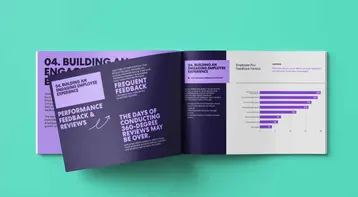
Table of contents
- 1.Understanding the Disconnect
- 2.Generational Differences in Benefits Perception
- 3.The Importance of Employee Benefits
- 4.Benefits as a Recruitment and Retention Tool
- 5.Insights and Learnings for Business Owners and HR Decision Makers
- 6.Enhance Benefits Communication and Support
- 7.Simplify Enrollment Technology
- 8.Prioritize Personalized Support
- 9.Conduct Regular Benefit Reviews and Surveys
- 10.Educate Employees on the Value of Benefits
- 11.In Conclusion
In the modern workplace, employee benefits play a pivotal role in attracting, retaining and engaging employees. Despite their importance, recent statistics highlight a significant disconnect between how employers perceive the ease of their benefits programs and how employees experience them. This gap may be more pronounced among different generational groups, with Gen Z employees particularly who tend to struggle more when navigating benefits-related processes based on a recent conducted survey. For small and medium-size business owners and HR decision makers, understanding these discrepancies and taking proactive steps to address them is crucial for maintaining a competitive edge in the job market.
Understanding the Disconnect
Employers often overestimate the ease with which employees can access and utilize their benefit programs. In a recent survey conducted by TriNet, State of the Workplace 2024, 59% of employees reported that they can easily access support for their benefits-related questions, and 58% find the technology for enrollment user-friendly, these numbers indicate that more than a majority of the workforce faces challenges. For Gen Z employees, the figures are even more concerning, with only 48% stating they can easily access support and just 52% finding the enrollment technology easy to use.
Generational Differences in Benefits Perception
Generational differences play a significant role in how benefit programs are perceived and utilized. Based on the survey linked above, Baby Boomers, for example, seem to have a better understanding on benefit programs, with 77% reporting easy access to benefits support and 82% feeling they have the necessary information. In contrast, Gen Z employees struggle considerably more, highlighting the need for targeted support and improved communication.
The Importance of Employee Benefits
Employee benefits are a critical factor in job satisfaction and decision-making. Employees highly value benefits, often citing them as a top reason for both leaving a job and considering a new one. Learn about the best employee benefits worth the investment to attract and retain top talent. Therefore, understanding how employees prioritize benefits and if they can easily access and utilize them is essential for business success.
Benefits as a Recruitment and Retention Tool
In a competitive job market, providing information that is readily available about the benefits program can be a significant differentiator for businesses. Employees who feel well-supported and informed about their benefits are more likely to remain loyal and engaged, reducing turnover and associated recruitment costs.
Insights and Learnings for Business Owners and HR Decision Makers
To bridge the benefits gap and enhance the employee experience, small and medium-size business owners and HR decision makers should consider the following insights and actionable strategies:
1. Enhance Benefits Communication and Support
Effective communication is key to supporting employees so they can understand their benefits. Employers should provide clear, concise and accessible information about benefit programs. This can include regular training sessions, easy-to-navigate online resources and personalized support.
Tailored Communication for Different Generations
Given the generational differences in benefits perception, tailored communication strategies are essential. For example, Baby Boomers may prefer detailed written information and one-on-one support, while Gen Z employees might respond better to digital communication, interactive tools and peer-to-peer assistance.
2. Simplify Enrollment Technology
The technology used for benefits enrollment should be intuitive and user-friendly. Employers should invest in modern, streamlined platforms that make it easy for employees to elect and manage their benefits. Regularly updating and testing these platforms can help identify and address usability issues.
Providing Training and Support for Technology Use
Offering training sessions and creating step-by-step guides can help employees navigate benefits enrollment technology more effectively. Providing access to a dedicated support team or helpdesk can also help ensure that employees receive timely assistance when needed.
3. Prioritize Personalized Support
Personalized support can significantly enhance the employee experience. Employers should consider assigning benefit advisors or creating dedicated support channels where employees can ask questions and receive tailored guidance.
Leveraging AI and Chatbots
Leveraging AI and chatbots can provide employees with immediate answers to common benefits-related questions. These tools can be particularly useful for Gen Z employees, who may prefer quick, tech-savvy solutions over traditional support methods.
4. Conduct Regular Benefit Reviews and Surveys
Regularly reviewing and updating benefit programs based on employee feedback can help align the offerings to remain relevant and valuable. Conducting surveys and focus groups can provide valuable insights into employee needs and preferences.
Addressing Feedback Promptly
Acting on feedback in a timely manner demonstrates that the organization values employee input and is committed to continuous improvement. This can help build trust and engagement among the workforce.
5. Educate Employees on the Value of Benefits
Employees may not fully appreciate the value of their benefits unless it is clearly communicated. Employers should highlight the financial, health and wellness advantages of the benefits offered, using real-life examples and case studies to illustrate their impact.
Creating a Benefits Education Program
Developing a comprehensive benefits education program that includes workshops, webinars and informational materials can help employees better understand and utilize their benefits. This program can be integrated into the onboarding process for new hires and offered periodically to all employees.
In Conclusion
The disconnect between employers' perceptions and employees' experiences with benefit programs highlight the need for improved communication, support and technology. By understanding and addressing these challenges, small and medium-size business owners and HR decision makers can create a more supportive and effective benefits environment. This not only enhances employee satisfaction and retention but also positions the organization as a desirable place to work in a competitive job market.
Addressing the benefits gap is not a one-time effort but an ongoing process that requires continuous attention and adaptation. By prioritizing employee needs, leveraging technology and fostering open communication, businesses can align their benefit programs to truly support and engage their workforce, leading to greater overall success.
This article is for informational purposes only, is not legal, tax or accounting advice, and is not an offer to sell, buy or procure insurance. It may contain links to third-party sites or information for reference only. Inclusion does not imply TriNet’s endorsement of or responsibility for third-party content.
TriNet Team
Table of contents
- 1.Understanding the Disconnect
- 2.Generational Differences in Benefits Perception
- 3.The Importance of Employee Benefits
- 4.Benefits as a Recruitment and Retention Tool
- 5.Insights and Learnings for Business Owners and HR Decision Makers
- 6.Enhance Benefits Communication and Support
- 7.Simplify Enrollment Technology
- 8.Prioritize Personalized Support
- 9.Conduct Regular Benefit Reviews and Surveys
- 10.Educate Employees on the Value of Benefits
- 11.In Conclusion






